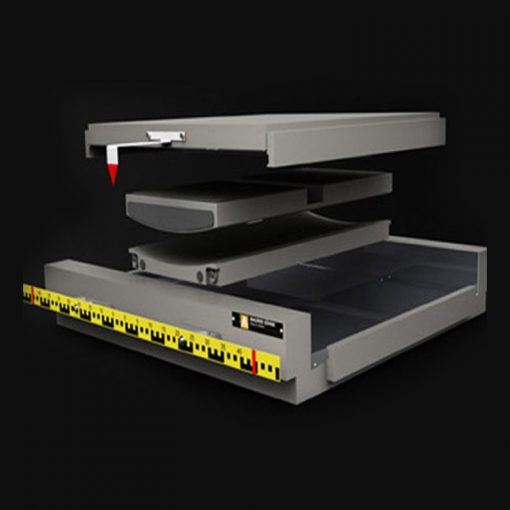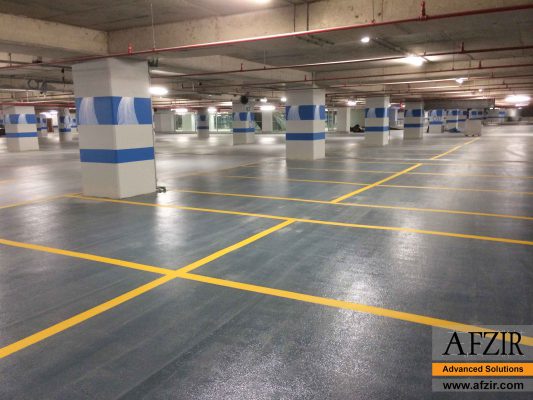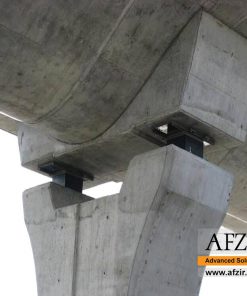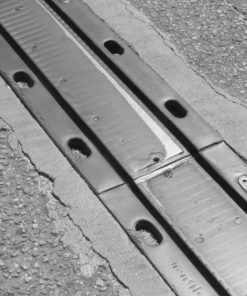PRODUCT DESCRIPTION
Maurer Company offers a comprehensive range of specialized supports and neoprene structures for various applications. These include:
- Uplift bearing supports: Designed to withstand vertical tensile and compressive forces, these supports are suitable for complex structures and bridges that experience load changes and high deformation, such as railway bridges.
- Neoprene Cradle Supports: Ideal for buildings with modern architecture, these supports can effectively handle point or line loads.
- Horizontal load-bearing: supports utilize guide elements instead of limiting factors to transmit horizontal and rotational forces.
- Roller bearings: Specifically designed for bridge replacement and repair operations.
- Force-measuring paddles: Equipped with sensors for continuous load measurement, these paddles effectively handle sudden changes in load.
- Cylindrical supports: Equipped with MSMM on upper and lower cylindrical surfaces, these supports suit roller neoprene replacement operations.
Role of Bridge Bearings:
Bridge bearings connect the bridge superstructure (deck) and the substructures (pier, viaduct, or abutment). They are crucial in accommodating various factors affecting the bridge structure, including temperature-induced expansion and contraction, seismic occurrences, and forces from heavy traffic. The functions of bridge bearings include:
- Connecting the bridge superstructure to the substructure.
- Accommodating and transferring dynamic forces and vibrations without causing damage to the substructure.
- Allowing movement (translational, vertical, or rotational) of the bridge structure in response to loads.
- Controlling the movement of the bridge structure in a specific direction and degree.
- Preventing large forces and moments in the substructure due to deformations.
- Adjust the dynamic properties of the bridge, if needed.
- Reducing shear on the head of piers, viaducts, or abutments.
- Acting as seismic protectors during earthquakes and other seismic activities.
Classification of Structural Bearings:
Bridge bearings can be classified based on several factors: support principle, material, design, and seismic isolation.
The classifications include:
a) According to the support principle:
Fixed or clamped bearing: Permits rotation but restricts transverse and longitudinal movement.
Hinge or pin bearing: Allows rotational movement while preventing longitudinal movement.
Movable bearing: Permits both rotational and translational movements.
Guided bearing: Allows only translational movements.
b) According to material:
- Steel bearing
- Rocker/Linear bearing
- Roller bearing
- Sliding plate bearing
- Combined roller and rocker bearing
- Rubber and combined bearing
- Laminated elastomeric bearing
- Plain elastomeric bearing
- Lead rubber bearing
c) According to design:
- Pot bearings
- Spherical bearings
- Elastomeric bearings
- Disc bearings
- ILM (incremental launch) bearings
- Lifting and measuring bearings
- Deformation bearings
- Special bearings
d) Seismic isolation bearings:
- Friction pendulum bearings
- Lead rubber bearings
- High-damping rubber bearings
Key Features
- carries the loads or movement in both vertical and horizontal directions from the bridge superstructure and transfers those loads to the bridge piers and abutments
- They permit movements like translation and rotation in between girders and pier caps of bridges to accommodate movements such as thermal expansion.
Applications
- Provides up to 4 hours rating on structural steel columns, beams, joists, trusses, floor and roof deck assemblies in commercial construction.
- Designed for use to exceed the 430 PSF (20.6 kpa) requirement for high rise construction.
- The durable surface and Portland cement based formulation of the product make it well suited for application in areas which may be subjected to high levels of abuse and such as mechanical rooms, perimeter steel structures, and parking garages.
Packaging
- –
Colour
- –
technical specifications
- Understand the specific requirements: Gain a comprehensive understanding of the project’s needs and performance expectations.
- Consult with experts: Seek guidance from experienced bridge engineers or specialists in bridge-bearing design.
- Consider durability and maintenance: Evaluate the durability and maintenance requirements of the special pillows.
- Evaluate load capacity and deformation: Analyze the special pillows’ load capacity and deformation characteristics.
- Perform thorough testing and analysis: Conduct appropriate laboratory or field testing to validate the performance of the special pillows.
- Follow design codes and standards: Adhere to relevant design codes and standards for bridge bearings.
- Consider long-term performance and life cycle costs: Evaluate the costs associated with the special pillows.
- Collaborate with manufacturers and suppliers: Establish effective communication and collaboration with manufacturers and suppliers.
- Monitor and assess performance: Implement a monitoring and inspection plan to evaluate the performance of the special pillows.
- Stay updated with advancements: Stay informed about bridge-bearing technology progress.
- Familiarize yourself with project requirements and specifications.
- Collaborate with engineers and designers for effective communication.
- Assign experienced personnel and ensure proper training.
- Follow manufacturer guidelines for installation procedures.
- Prepare the installation area adequately.
- Handle special pillows with care during transportation and installation.
- Ensure proper alignment and positioning during installation.
- Use approved methods and materials for installation.
- Implement quality control checks to verify proper installation.
- Document the installation process for future reference.
- Coordinate with other trades involved in the project.
- Provide training and instructions to subcontractors, if applicable.
- Prioritize safety throughout the installation process.
- Establish a maintenance plan for the special pillows.
- Seek manufacturer support for technical guidance and assistance.
- Preparation: Ensure that the bridge substructure is appropriately prepared and meets the requirements for installing the special pillows. This includes cleaning the contact surfaces and removing any debris or contaminants.
- Positioning: Determine the correct locations for placing the special pillows on the bridge substructure. Refer to the design plans and specifications to ensure accurate placement.
- Alignment: Align the special pillows by the design requirements. Use appropriate tools and measurements to ensure precise alignment and positioning.
- Fixing: Securely fix the special pillows to the bridge substructure using approved fasteners or adhesive methods. Follow the manufacturer’s guidelines and recommendations for the specific type of special pillows being installed.
- Load Distribution: Ensure the load is evenly distributed across the special pillows. Adjust and verify the load distribution to prevent excessive stress on any pillow.
- Verification: Conduct quality control checks to confirm that the special pillows are correctly installed and meet the specified standards. This may involve measurements, inspections, or load testing as required.
- Documentation: Maintain detailed documentation of the installation process, including photographs, measurements, and any deviations or adjustments made during the installation. This documentation will be valuable for future reference, maintenance, and potential warranty claims.
- Post-installation Checks: After installation, monitor the performance of the special pillows. Periodically inspect and assess their condition to ensure they are functioning as intended and to identify any signs of wear, damage, or the need for maintenance.
It is important to note that the specific application process may vary depending on the type and design of the special pillows being used. It is recommended to consult the manufacturer’s instructions and seek guidance from experienced professionals to ensure proper installation of the Special Pillows for Structural Bridge Bearings.
- Develop a comprehensive quality control plan for Special Pillows for Structural Bridge Bearings.
- Define clear acceptance criteria based on specifications, design plans, and standards.
- Conduct a pre-installation inspection to ensure the pillows are defect-free.
- Verify proper installation through regular inspections, checking alignment, and fixing methods.
- Perform load testing to assess pillow performance under expected loads.
- Implement monitoring and documentation systems to track pillow performance over time.
- Consider non-destructive testing methods to assess pillow integrity.
- Evaluate maintenance and repair needs periodically to ensure continued performance.
- Ensure compliance with industry standards and regulations.
- Continuously improve quality control processes based on analysis and corrective actions.















Be the first to review “Special Pillow For Structure”